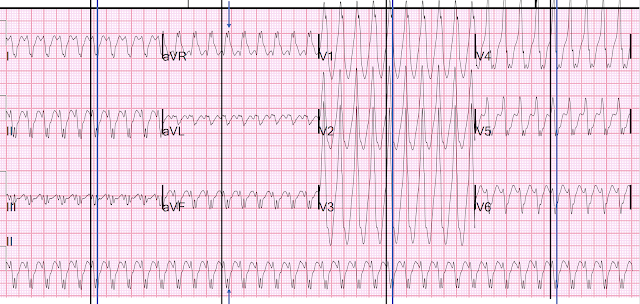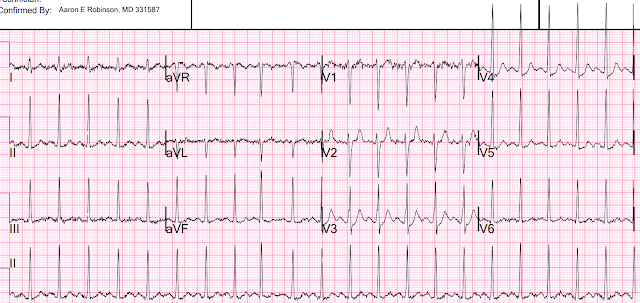A 30-something male without any significant past medical history presented with palpitations and presyncope.
Here is his ED ECG:
First. Before getting into analysis, a regular wide complex tachycardia could be
1. ventricular tachycardia (VT) or
2. AV reciprocating tachycardia (AVRT, antidromic WPW) or
3. SVT with aberrancy. (SVT would usually be AVNRT or orthodromic WPW)
Since adenosine is safe in VT, and it works for AVRT and AVNRT, it is worthwhile trying adenosine. Or, of course, you can always use electrical cardioversion.
Providers gave 6 mg of adenosine with no response, followed by electrical cardioversion.
This is what I texted back: "VT or AVRT. (Antidromic WPW). I am sure you already shocked it, right?"
Next. ECG analysis: This is a regular wide complex tachycardia. There are no P-waves. The QRS onset is very slow. See magnified leads below. The time from QRS onset to peak is approximately 110 ms.
This is too long for either AVNRT or for Idiopathic VT. Briefly, idiopathic VT is VT in an otherwise normal heart and initiates in conducting tissue and therefore has a rapid onset similar to SVT with aberrancy). See this post: Idiopathic Ventricular Tachycardias for the EM Physician.
Such a slow onset is appropriate for VT in the context of myocardial disease, or for AVRT.
Here I put a lines, or arrows, at the onset (black) and end of the ONSET (blue) of the QRS. I started in lead II at the bottom, where it is easiest to see the onset.
Here is the post cardioversion ECG (texted to me):
This what I texted back: "Could be WPW. You don’t always see Delta waves."
After cardioversion, echo showed excellent LV function.
Final analysis:
1. Good LV function means that if this is VT it would likely be idiopathic VT
2. But idiopathic VT should have a rapid onset
3. This has a slow onset, so it is unlikely to be either type of VT.
4. Finally, Right ventricular outflow tract VT, which responds to adenosine, has an LBBB morphology and inferior axis, which is not present here.
5. Therefore AVRT is most likely, even though there are no delta waves.
This was the note of our electrophysiologist:
“… Although the morphology is consistent with ventricular tachycardia, we cannot completely rule out antidromic AVRT originating from LV base insertion site of an accessory pathway. The EKG during sinus rhythm does not show robust preexcitation, but we will keep in mind that for left-sided accessory pathways may not show robust preexcitation during sinus rhythm since this is essentially dependent upon relative conduction of the AV node versus accessory pathway (if any).”
Outcome
Electrophysiologic study showed an accessory pathway (WPW, antidromic AVRT)
Why did adenosine not work? 6 mg often does not work, but especially in low flow states. Our electrophysiologist, Rehan Karim, explains: "At this HR in general one might expect overall transit time for any IV drug to be very slow to reach the heart. Adenosine as you know has very short half life so a small dose like this probably would fade away before it would reach the target area."
===================================
MY Comment by KEN GRAUER, MD (5/14/2022):
===================================
- As per Dr. Smith — the initial rhythm in today's case is a regular WCT ( = Wide-Complex Tachycardia) at ~230/minute, without clear sign of atrial activity. Dr. Smith suggested the following Differential Diagnosis for this WCT rhythm: i) VT; ii) Antidromic AVRT (in a patient with WPW); and/or, iii) SVT with aberrant conduction.
- I'd add: iv) SVT with preexisting BBB (Bundle Branch Block) to the above differential diagnosis — as instead of an initially narrow QRS complex (that manifests aberrant conduction as a result of the rapid rate) — the etiology of this regular WCT rhythm could be an SVT in which the QRS was already widened (ie, "preexisting" BBB).
- Dr. Smith narrowed the likely differential for aberrantly-conducted SVT to either AVNRT or orthodromic AVRT. This is because the ventricular rate of ~230/minute for today's tracing is too fast for sinus tachycardia in an adult — it is slower-than-would-be-expected for 1:1 AFlutter — and — faster-than-would-be-expected for 2:1 AFlutter. While Atrial Tachycardia could be possible at this rate — ATach is far less common in practice than either of the reentry SVT rhythms (which are AVNRT and AVRT).
- Dr. Smith highlighted delay in the initial conduction time (perhaps seen best in the slow upslope for the R wave in leads V1-thru-V4 — as well as measured in Dr. Smith's magnified view of lead aVR that is shown above). This delay in initial conduction of the QRS makes it much less likely that a supraventricular mechanism is operative (since initial conduction with AVNRT and orthodromic AVRT is usually fast, being transmitted over the normal AV nodal pathway).
- PEARL #1: Getting an Echo when your arrhythmia patient is stable can sometimes prove highly insightful for determining the rhythm. For example, in today's case — Knowing that the Echo obtained after conversion to sinus rhythm revealed normal LV function — allowed Dr. Smith to deduce that ischemic VT was unlikely (since this entity is almost always associated with at least some impairment of LV function).
- Use of Echo therefore narrowed diagnostic considerations for today's rhythm to 2 entities: i) Antidromic AVRT (in a patient with WPW) — vs — ii) Idiopathic VT (ie, that group of ~10% of all VTs that occurs in patients who do not have underlying heart disease).
- While exceptions exist — supraventricular conduction with QRS widening (ie, from either aberrancy — or from preexisting bundle branch block) — tends to resemble some form of conduct defect (ie, either RBBB, LBBB, or RBBB with LAHB or LPHB). QRS morphology in today's initial tracing does not resemble any known form of conduction defect because: i) The uniformly amorphous and slurred complexes in leads V1-thru-V4 are completely lacking in the triphasic appearance that RBBB typically shows in lead V1 — and — lacking in the usual progression of an RBBB pattern as one moves across other anterior leads; and, ii) The multiphasic (fragmented) and virtually isoelectric complex in lead III is not consistent with any known hemiblock pattern.
- QRS morphology in today's initial tracing is not consistent with either of the 2 most common forms of idiopathic VT — which are RVOT VT (Right Ventricular Outflow Track VT) and Fascicular VT. I've reproduced the summarizing Table from my discussion of this topic in the February 14, 2022 post in Dr. Smith's Blog in Figure-1. Today's initial tracing is not RVOT VT — because it does not have an LBBB-like appearance in the chest leads. This initial tracing is also unlike Fascicular VT because it is too wide, too amorphous in its anterior lead shape, and too fragmented and isoelectric in lead III. While a small percentage of the idiopathic VTs manifest a less recognizable QRS morphology — the initial delay in conduction (as per Dr. Smith), marked QRS widening, and other morphologic features described above make idiopathic VT highly unlikely as the diagnosis.
- In contrast — the very rapid rate of today's reguar WCT rhythm — in association with the initial slurring of the wide positive complexes in most chest leads would seem perfectly consistent with antidromic AVRT.
- PEARL #3: It is not always possible to distinguish between VT vs antidromic AVRT from an initial ECG showing a regular WCT rhythm. Statistically — over 95% of such rhythms will turn out to be VT. Clinically — this distinction is not essential, since appropriate initial management considerations are usually similar (ie, both rhythms will respond to electrical cardioversion).
- That said — today's case is insightful for illustrating how use of Echo and assessment of QRS morphology may guide diagnostic considerations. Knowing that the probable etiology of the very rapid WCT in today's case is antidromic AVRT can help expedite definitive therapy — which will be EP referral for ablation of the patient's "culprit" accessory pathway.
-USE%20copy.png) |
| Figure-1: Review of KEY features regarding Idiopathic VT (CLICK HERE — for the source of this Summary). |





No comments:
Post a Comment
DEAR READER: I have loved receiving your comments, but I am no longer able to moderate them. Since the vast majority are SPAM, I need to moderate them all. Therefore, comments will rarely be published any more. So Sorry.